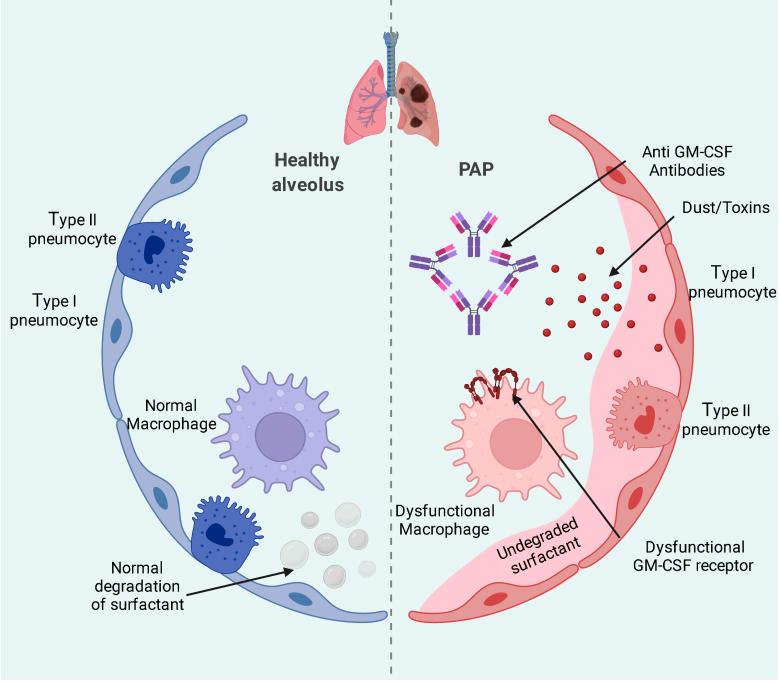NAA Associated Pulmonary Alveolar Proteinosis (PAP)
Pulmonary alveolar proteinosis (PAP) is a syndrome featured by the accumulation of surfactant in alveoli and terminal airways resulting in hypoxemic respiratory failure. Empowered by our advanced high-resolution analytical platforms and experienced technical team, the analytical division at Creative Biolabs is fully competent and dedicated to serving as your one-stop-shop for natural autoantibodies (NAA) analysis and characterizations. Creative Biolabs offers a comprehensive set of NAA services to assist our clients to perform autoantibody detection, NAA profiling, affinity measurement and provides a guideline for PAP project.
Introduction of Pulmonary Alveolar Proteinosis (PAP)
PAP includes part of a spectrum of disorders of surfactant homeostasis (clearance and production). Surfactant is synthesized and secreted by alveolar type II epithelial cells, removed by uptake, recycling, and catabolism in these epithelial cells and by uptake and catabolism in alveolar macrophages. Pulmonary surfactant maintains lung function by creating an air-liquid interface on the alveolar surface, reducing surface tension and preventing alveolar collapse. Granulocyte-macrophage colony-stimulating factor (GM-CSF) is required for the catabolism of surfactant in alveolar macrophages. The surfactant clearance disorders are caused by disruption of GM-CSF signaling (primary PAP) or by an underlying disease that impairs alveolar macrophage functions including surfactant catabolism (secondary PAP). Primary PAP is related to alveolar macrophage dysfunction due to the disruption of GM-CSF signaling caused by a high serum level of Anti-GM-CSF autoantibody (autoimmune PAP) (~90%) or by the mutations in the GM-CSF receptor genes (hereditary PAP) (~10%).
 Fig.1 Normal surfactant clearance (blue) and changes occurring in PAP (red).1
Fig.1 Normal surfactant clearance (blue) and changes occurring in PAP (red).1
Symptoms and Signs of PAP
Common symptoms of PAP include fatigue, exertional dyspnea, cough, and weight loss. In autoimmune PAP, a smoking history is commonly present and dust or fume exposure also have been reported. Elevated serum anti-GM-CSF autoantibody is an indicator used in the diagnosis of autoimmune PAP in patients with typical history, radiologic findings, bronchoalveolar lavage cytology findings with a milky, turbid appearance and/or lung biopsy.
Anti-GMCSF Autoantibody Treatment in Autoimmune PAP
In autoimmune PAP, disease-specific biomarker known to be elevated in serum is the GM-CSF autoantibody. This test is simple and standardized. It can be used to identify the PAP disease in many patients. The reported sensitivity and specificity for autoimmune PAP approach to 100%. If a patient is suspected to have PAP, early anti-GM-CSF autoantibody testing is useful to make the diagnosis of autoimmune PAP. Whole lung lavage (WLL) is the standard first-line therapy and GM-CSF inhalation for autoimmune PAP is a promising therapy under clinical study.
Features of our Technologies
- ELISA /WB /Dot Blot / LIPS
- Protein Array /Peptide Array
- Multiple Affinity Protein Profiling (MAPPing)
- Low Cost
- Best After-sale Services
As mentioned before, NAA testing is useful to make the diagnosis of autoimmune PAP and can minimize the use of more invasive procedures. Creative Biolabs has developed and utilized several high-throughput technologies for the analysis of NAA. With expertise and dedication, Creative Biolabs will be your best partner in NAA research. Please do not hesitate to contact us for more information and a detailed quote, if the disease and related targets you interested is not mentioned above.
Reference
- Cimpoca Raptis, Brindusa Ana, et al. "Pulmonary Alveolar Proteinosis and Pregnancy: A Review of the Literature and Case Presentation." Medicina 58.8 (2022): 984.
Choosing natural autoantibody (NAA) microarray to profile autoantibody repertoire and reveal novel disease's marker.

